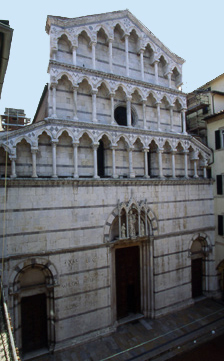Pisa - Church of San Michele in Borgo

The church and the monastery of San Michele in Borgo were built at the beginning of the XI century outside the town walls. It was raised on a Roman temple dedicated to Mars, the god of war, and it was at the centre of a settlement called Borgo which developed along the way heading northwards.
From an ancient text written by San Michele in Borgo's first abbot, it can be learnt that he went to Pisa in 1046, after being invited by a nobleman of the city, to transform the then Church of San Michele Arcangelo, that was under the authority of the cathedral, into a Benedictine monastery. Thus, he started the construction of an architectural masonry complex that substituted the previous wooden structure of which not much exists today.
It can be hypothesized that the crypt of the existing church belonged to the ancient building. Instead, the existing building was raised between the XII and the XIII century. the facade was made by Fra' Guglielmo, the Dominican monk that finished it between 1302 and 1312 taking his inspiration fro the Pisan cathedral. The tabernacle and the group of statues that decorate the inside were placed around the first half of the XIV century.
The facade underwent some changes in the XIX century, but it basically remained as Fra Guglielmo conceived it and carried it out. As many other constructions of that period, the facade also has two styles typical of that period, in the upper part above all, where the Romanesque-Pisan lodges are decorated with little arches and heads carved in the Gothic style. In the lower part, there are three entrances.
Above the central one, there are some traces of goliardic writings dating to 1558 when the new University rector was elected.
The inside of the church was partially rebuilt in the postwar period. It is divided into one nave and two aisles with a lifted altar zone because of the crypt beneath. On the north nave, a XIV-century marble crucifix created by Nino Pisano is set. Other decorations can be seen inside the Museo Nazionale di San Matteo, among which there is a XII-century "Madonna col Bambino".
Moreover, in the church there were five ancient sarcophagi that were transferred to the Camposanto in Piazza dei Miracoli. Instead, the capitals of the interior colonnades seem to have come from a different place.